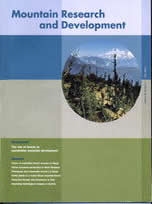Special Issue: The Role of Forests in Sustainable Mountain Development
Articles (2)
Development (8)
Research (6)
Mountain Notes (3)
Mountain Media (4)
Mountain Meida (1)

No abstract available
No abstract available
No abstract available
No abstract available
No abstract available
No abstract available
No abstract available
No abstract available
No abstract available
No abstract available
No abstract available
No abstract available
